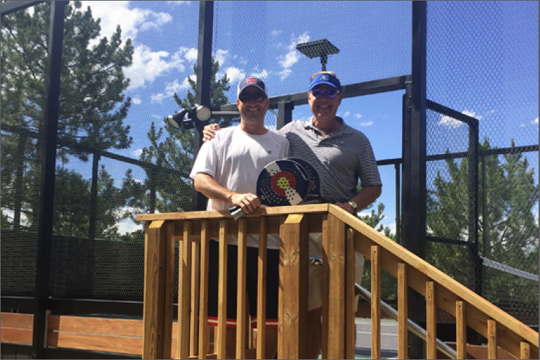It Takes a Village
November 20, 2015
Cherry Hills Village, CO
In 2013, members of the Arapahoe Tennis Club began to realize their need for a new platform tennis court. ATC is located in Cherry Hills Village, a small but sophisticated suburb just south of Denver. ATC has had four platform courts since the 1980s but with the growing popularity of the sport amongst its members, the membership elected to expand its facilities by one court.
Club president Don MacKenzie and ATC member Dan Sheldon provided a vision for the development and led the initial site planning. The process became a delicate balance of honoring the needs and wants of the private club for retention of open space and children’s play areas, to cooperating with the surrounding neighbors regarding the impact of the new facility, to meeting the building and zoning codes within Cherry Hills Village.
Little did these two volunteers know, the club’s desire for an additional court would lead them through extensive negotiations with neighbors and the village. The ATC analyzed four potential locations for the added court and a small warming hut, eventually landing on the approved site after extensive discussions with neighbors, city staff, and ATC members, and three hearings of the planning commission and two hearings of the city council. Each of these interactions was an attempt to balance disparate needs of the varied constituents. Extensive dialogue took place within the ATC, including a special meeting of past presidents of the 50-year-old club.
“When you get 20 or 30 of the past presidents in the room to discuss an issue, you’re going to get a tremendous amount of insight from folks that have been integrally involved in the club for decades,” said MacKenzie. “This input was invaluable for our long-range planning.”
This ongoing dialogue led to Sheldon and MacKenzie investigating two other possible locations for the new platform tennis court. One would be trying to wedge the court in between existing tennis and platform courts, and the other was the existing location of a tennis backboard and basketball court. Weeks turned into months and it became apparent that the club was in favor of losing the tennis practice area and basketball court in favor of the new platform court. That location seemed to be one that the neighbors would also embrace as it was surrounded by a dozen 30-foot-or-taller trees and it seemed the court would blend in nicely.
Once Sheldon and MacKenzie received approval from the club, they took the concept to the city and the neighbors. Some neighbors were strongly against the proposed location, their concerns centering on noise and light and the potential impact on surrounding residences that are mostly on two-plus acre lots. Even with an application that was compliant with the city, some neighbors attempted to block the development.
With the cooperation from its general contractor, the lighting engineer, and manufacturer, as well as a host of consultants ranging from civil engineers and land planners to traffic engineers and ADA compliance personnel, the ATC expended an extraordinary amount of energy and resources in seeking approval for the new court. “We could have built a downtown skyscraper for this same amount of effort,” joked Sheldon. “In order to reach an agreement with the neighbors and the city, we had to do extensive research on the lumens and kelvin levels (light temperature) of the new LED lights that were proposed for the new court.”
The two-year journey took Sheldon, MacKenzie and current ATC president Tom Burkholder through a number of hearings that eventually led to the approval and construction of Court 5 as well the approval of the future warming hut. Some of the concessions that the club was required to provide included converting the platform tennis courts’ heat source from propane to natural gas at a cost of $80,000, a dozen new pine trees ranging from 12 to 24 feet in height and costing nearly $20,000, a new block wall dumpster enclosure at an estimated cost of $10,000, improvements to the parking lots, as well as custom made back and side shields on the new LED lights.
“Listening to our own membership’s concerns, cooperating with the neighbors, and complying with the city of Cherry Hills Village has brought us all closer together, and we’ve learned to be better neighbors because of it. In the end, it takes a village to be successful,” said Burkholder.







